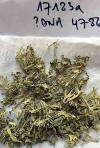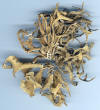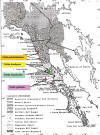|
W of Bahía de Tortugas, towards Punta Eugenia, N 27°49.701 W 115°03.454 35-40 m, Spjut & Sérusiaux 17183a-4786, Jan 2016, salazinic acid |
W of Bahía de Tortugas, towards Punta Eugenia, N 27°49.701 W 115°03.454 35-40 m, Spjut & Sérusiaux 17183b-5111, Jan 2016, salazinic acid |
W of Bahía de Tortugas, towards Punta Eugenia, N 27°44.969 W 114°56.690, 140-160 m. Spjut & Sérusiaux 17185a-4789, Jan 2016, hypoprotocetraric acid |
|
W of Bahía de Tortugas, towards Punta Eugenia, N 27°44.969 W 114°56.690, 140-160 m. Spjut & Sérusiaux 17185b-4789, Jan 2016, salazinic acid, DNA not extracted |
|
Niebla
spatulala hybrid complex, partial vegetative hybridization by
fusion of two different thalli evident. 17179 previously included under
N. homaleoides (left thallus) by the absence of triterpenes and
depsidones (acid deficient). Right thallus with divaricatic acid
and salazinic acid (N.
contorta x
N. spatulata). |
|
W of Bahía de Tortugas, towards Punta Eugenia, N 27°44.969 W 114°56.690, 140-160 m. Spjut & Sérusiaux 17203e-4805, Jan 2016, hypoprotocetraric acid |
W of Bahía de
Tortugas, towards Punta Eugenia, N 27°44.969 W 114°56.690, 140-160 m. |
W of Bahía de Tortugas,
towards Punta Eugenia, N 27°44.969 W 114°56.690, 140-160 m. |
|
7 mi S of Rosarito along Hwy 1, Spjut 10511, Apr 1989, hypoprotocetraric acid, northernmost occurrence of the Southern Vizcaíno Desert, north of Guerrero Negro
|
Vizcaíno Peninsula, Sierra Hornitos, Spjut 9704A, May 1986, hypoprotocetraric acid |
Isla Cedros, Spjut & Marin 10546 (salazinic acid) & 10547 (hypoprotocetraric acid), Apr 1989 ,
|
|
W of Bahía de Tortugas, towards Punta Eugenia, N 27°44.969, W 114°56.690, 140-160 m, Sérusiaux 17194A-4795. Jan 2016, salazinic acid |
W of Bahía de Tortugas, towards Punta Eugenia, N 27°49.701 W 115°03.454 35-40 m, Sérusiaux 17186A-5112. Jan 2016, has unknown terpene (Rf ± norstictic acid) as minor component in addition to salazinic acid |
Sierra Hornitos,
|
|
Niebla spatulata complex
|
Map showing collection sites |
Illustration of TLC data for species of Niebla |



















